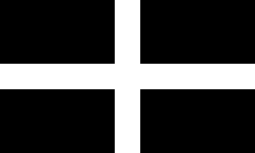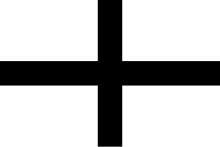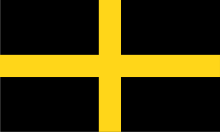Saint Piran's Flag
 | |
| Other names | St Piran's Flag, Baner Peran, An Gwynn ha Du |
|---|---|
| Use | Civil flag |
| Proportion | 5:3 |
| Adopted | 19th century |
| Design | A white cross on a black background. |



Saint Piran's Flag (Template:Lang-kw) is the flag of Cornwall, England, UK. The earliest known description of the flag as the Standard of Cornwall was written in 1838.[1] It is used by some Cornish people as a symbol of identity.[2] It is a white cross on a black background.
The flag is attributed to Saint Piran, a 6th-century Cornish abbot. One early use of a white cross and black background design is the 15th-century coat of arms of the Saint-Peran family.[3]
At the Thames Diamond Jubilee Pageant in June 2012, the flag was among those flown on the Royal Barge, Gloriana, though this was explained as "innocent" and "nothing constitutional".[4]
Origins
There are claims that the design dates from prior to 1188 when the flag was used in the Crusades,[unreliable source?][5] and an article in the Encyclopædia Britannica tells that the flag was carried by the Cornish contingent at the Battle of Agincourt (1415).[6][7] [unreliable source?] However, the reference given by the Encyclopædia Britannica seems to have been confused with one that comes from a 1590 poem entitled Poly-Olbion by Michael Drayton. It states that the banner carried by the Cornish men at Agincourt depicted two Cornish wrestlers in a hitch.[8]
The earliest known evidence of this flag was recorded by Davies Gilbert in his 1838 work: The Parochial History of Cornwall, in which he gives reference to
a white cross on a black ground [that] was formerly the banner of St Perran and the Standard of Cornwall; probably with some allusion to the black ore and the white metal of tin[1][2]
The fact that Gilbert identifies it as being "formerly" a standard of Cornwall implies that he believed it to have been used before 1838.[1] However, Gilbert did not leave a record of his background research, and referred only to his "recollection".[2]
One of the oldest depictions of the flag can be seen in a stained glass window at Westminster Abbey. It was unveiled in 1888, in memory of the famous Cornish inventor and engineer Richard Trevithick. The window depicts St Michael at the top and nine Cornish saints, Piran, Petroc, Pinnock,[9] Germanus, Julian, Cyriacus, Constantine, Nonna and Geraint in tiers below. The head of St Piran appears to be a portrait of Trevithick himself, and the figure carries the banner of Cornwall.[10]
Clues to its origin
This section needs additional citations for verification. (June 2010) |
Saint Piran's Flag has similarities to the old Breton flag and the flag of Saint David. The cultural links between Brittany, Wales and Cornwall are well recorded. Saint Piran's Flag is the negative image of the old Breton flag, a black cross on a white field. The flag of Saint David shares a black background with Saint Piran's Flag, but is surmounted by a gold, rather than a white, cross.


It has also been suggested that it may have been based on the arms of the Earl of Cornwall, or the later Duchy of Cornwall; based on the arms of other Cornish families; or be linked with the black and white livery of the Knights of St John.[2]
French and Breton family arms
This section needs additional citations for verification. (June 2010) |
The arms of the Saint-Peran family in Brittany, show a white cross pattee on a black field.
-
Arms of Geoffroy le Borgne
-
Arms of the Arnèke family
-
Arms of Rouvroy de Saint-Simon
-
Arms of Saint-Pezran family (Brittany)[11]
Several other French and Breton families also had coats of arms that bear a striking resemblance to the St Piran's flag:
- Saint Peran or Saint Pezran (= Piran) of Brittany (from Glomel, in Cornouaille), is described as, "sable a cross patée argent".
- Geoffroy le Borgne of Brittany is described as "de sable à croix d'argent".[12]
- Rossillon de Gex, coat of arms described: "De sable à la croix d'argent".
- Brunet, de la Besse, coat of arms described: "D'azur, à la croix d'argent".[13]
- Arnèke Family coat of arms.[14]
- Rouvroy de Saint-Simon of Picardy, described: "De sable à la croix d'argent chargée de cinq coquilles".[15]
Usage
This section needs additional citations for verification. (July 2009) |
The flag is often displayed on bumper stickers, and flying from buildings, including those of Cornwall Council.[16] It is flown at most Cornish gatherings, such as the Gorseth Kernow, St Piran's Day (5 March), Camborne's Trevithick Day (April), Padstow's 'Obby 'Oss festival (May), Helston's Flora Day (May), and at Cornish rugby matches. It is regularly seen around Cornwall on car stickers with the word Kernow (Cornish for Cornwall), and is used around the world as a symbol of the Cornish diaspora or overseas Cornish associations. It has been adapted for use in the logos of a number of organisations, such as the Cornwall district of the Methodist Church, is used by a variety of Cornish businesses such as Ginsters, and is seen on the design of the Cornish All Blacks rugby shirts as well as the Cornish Pirates rugby logo.[16][dead link]
At the Thames Diamond Jubilee Pageant in June 2012, the flag was flown on the Royal Rowing Barge alongside the flags representing England, Scotland, Northern Ireland, Wales and the City of London. One of the largest flags in the pageant was also St Piran's Flag, flown by the St Ives mackerel lugger Barnabas.[17]
Gallery
-
Cornish Pirates RFC logo showing the Saint Piran's Flag
-
The flag of the Duke of Cornwall
See also
- Hermann grid illusion
- List of Cornish flags
- Cornish heraldry
- The Flag of the Duchy of Brittany
- List of topics related to Cornwall
- St Piran's Day
References
- ^ a b c 'The Parochial History of Cornwall', by Davies Gilbert. (1838) Vol III, p. 332
- ^ a b c d Phil Rendle, Cornwall – The Mysteries of St Piran, The Flag Institute
- ^ P. POTIER de COURCY, Nobiliaire et armorial de Bretagne, A. Aubry, 1862, p390
- ^ [1]
- ^ Celtic League flags
- ^ Heraldry Society Flag Section Newsletter, Autumn 1969
- ^ Cornish flag
- ^ Poly-Olbion by Michael Drayton
- ^ http://www.catholic.org/saints/saint.php?saint_id=5453
- ^ Westminster Abbey
- ^ Guide des drapeaux bretons et celtes (English: Guide of Breton and Celtic flags) by Divi Kervella and Mikael Bodlore-Penlaez, published by Yoran Embanner (in French), (2008) ISBN 978-2-916579-12-2
- ^ http://www.briantimms.com/vermandois/bretons.htm
- ^ visu_armes_p
- ^ La page du généalogiste fou ... L'héraldique
- ^ rouvroy
- ^ a b How far has the “Cornish Revival” affected modern Cornwall? Archived 2011-10-08 at the Wayback Machine
- ^ "St Ives lugger flies the flag at Jubilee river pageant". Falmouth Packet. 6 June 2012. Retrieved 7 June 2012.
External links
- Flags of the World – Speculations of the origins of this flag.
- The Flag Institute




![Arms of Saint-Pezran family (Brittany)[11]](http://upload.wikimedia.org/wikipedia/commons/thumb/0/06/Blason_de_la_famille_de_saint-pezran.svg/109px-Blason_de_la_famille_de_saint-pezran.svg.png)

